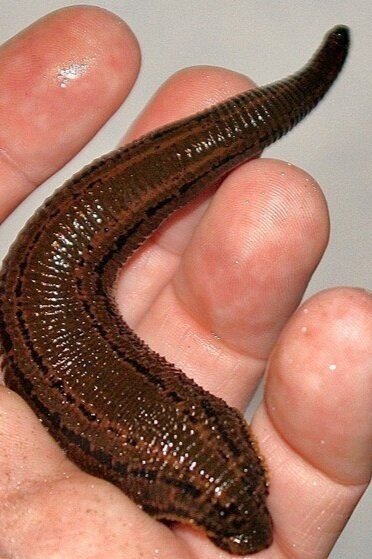Leeches in the landscape - a look into the past
The historic wetlands of the Lower Ure and Swale valleys have some fascinating stories to tell. Welcome to the first in our series of occasional blogs giving an insight into this heritage. Written by Martin Hammond
Most of our understanding of the historic wetlands in the lower Ure and Swale valleys is based on botanical records, landscape history and environmental archaeology. Direct evidence of wetland fauna is rather scarce, at least for the historic period, though we can make some inferences from other parts of Yorkshire. A notable exception is the Medicinal Leech, a native invertebrate of shallow meres and ponds.
In some ways the Medicinal Leech needs no introduction – this is the blood-sucking creature beloved by physicians for treating all manner of ills, from ancient times into the late 19th century. By the early 1800s, the European leech trade ran into millions of animals, resulting in over-collecting of indigenous populations and an increasing dependence on imports. This led to a huge reduction in range and numbers. Medicinal Leeches need warm, shallow water with either abundant amphibians or grazing animals to provide them with blood meals, so drainage of wetlands compounded the impact of over-collecting. Today Medicinal Leeches survive only in a few refugia in Britain, in the Lake District, Wales, the New Forest and the Kent marshes. In recent decades, veterinary drugs and other factors have led to an ongoing decline in some of the species’ few remaining strongholds.
The only published records of Medicinal Leech for Yorkshire come from Randy Mere (now a concrete-lined reservoir) near Goathland on the North York Moors and Strensall Common in the Vale of York. It survived at both locations into the 1940s but has not been seen since. However, place name evidence and historical references show that it was once more widespread, with an important centre in the lower Swale and Ure valleys.
Meet Mr. Leech!
George Walker’s Costumes of Yorkshire (1814) included an engraving of women collecting leeches, the accompanying commentary noting that although “comparatively scarce” due to the demands of the apothecary trade, Medicinal Leeches were “still found in many parts of Yorkshire”.
We can see unique evidence of this locally in the form of the ornate Georgian Leech House beside Bedale Beck at Aiskew. This is the only remaining Medicinal Leech warehouse, where wild-collected leeches were kept in containers with peat and moss ready to be transferred to jars for onwards sale. The Leech House was run by a Bedale apothecary and employed a collector called George Thornton.
Bedale Medicinal Leech House by Rosser1954, CC BY-SA 4.0, via Wikimedia Commons
The Leech House is more than a picturesque curiosity. By the mid 19th century, such was the demand that York apothecaries advertised “fresh Hamburg leeches”, in fact sourced from the Baltic countries. That Aiskew/Bedale maintained its own supply shows that there were still sufficient ponds and wetlands to meet local demands. Twenty or thirty years before the Leech House was constructed (the date is uncertain), Thomas Jeffrey’s 1771 Map of Yorkshire showed a large mere (natural lake) at Snape Mires to the south of Bedale.
At one time this must have been one of North Yorkshire’s great wetlands. Estate records show that by the end of the 18th century, Snape Mires had largely been drained but there were presumably sufficient pools and wet ditches to provide a supply of Medicinal Leeches. Another likely source was the Leech Pond near Burrill, which still bears that name today.
You can find more about the Freshwater Habitats Trust’s Medicinal Leech Recovery Project here:
https://freshwaterhabitats.org.uk/medicinal-leech-recovery-project/




